When it comes to Rottweiler growth, one question that often arises is when their head fills out. Understanding the development of a Rottweiler’s head is important for breed enthusiasts and pet owners alike. In this article, we will explore the growth timeline of a Rottweiler’s head, the differences based on gender and breeding lines, and the factors that influence their head proportions.
Rottweilers have two main types of heads – a slender skull typical of American Rottweilers, and a massive skull typical of German and European lines. The ideal head size for a Rottweiler is medium-sized with a good distance between the ears and moderately protruding fronts.
During the first year of a Rottweiler’s life, there is a growth spurt, where the head and legs grow faster than the body. By the second year, the Rottweiler will reach its full height and start to fill out, developing muscle. Some Rottweilers may continue to gain weight and fill out until their third year. Male Rottweilers typically have larger head sizes than females, and different breeding lines may result in variations in head size and shape.
Understanding the growth timeline and characteristics of a Rottweiler’s head is key to ensuring their healthy development. Let’s dive deeper into the differences based on gender, breeding lines, and the timelines of Rottweiler head growth.
Key Takeaways:
- The growth of a Rottweiler’s head continues until two to three years of age.
- Rottweilers have two main types of heads – slender and massive, depending on breeding lines.
- Male Rottweilers generally have larger head sizes than females.
- American Rottweilers typically have lighter heads compared to German Rottweilers.
- Proportions of a Rottweiler’s head are primarily determined by genetics and breeding.
Rottweiler Head Size Differences Based on Gender
When it comes to Rottweilers, there is a noticeable difference in head size between males and females. Male Rottweilers generally have bigger heads compared to their female counterparts. This difference in head size is usually proportional to their overall size and physical development.
For example, a big male Rottweiler typically has a skull length of around 15 centimeters, while a big female Rottweiler’s skull length is slightly less than 13 centimeters. Similarly, the width of an adult male Rottweiler’s skull measures about 16 centimeters, whereas females have a width just over 14 centimeters.
Types of Rottweilers and Head Size Differences
Rottweilers come in different types with varying head sizes, primarily influenced by their breeding lines. Two notable types are American Rottweilers and German Rottweilers.
American Rottweilers:
American Rottweilers tend to have lighter heads and are generally smaller in size compared to their German counterparts. This type of Rottweiler is known for its agile and sleek appearance.
German Rottweilers:
On the other hand, German Rottweilers have thicker bones and broader, blockier heads. They are bred according to stricter standards, resulting in a more robust and powerful physique.
The contrast in head size between American Rottweilers and German Rottweilers is easily noticeable. While American Rottweilers exhibit a lighter head type, German Rottweilers showcase a more substantial and imposing head structure.
It’s important to note that while there are variations like “Serbian Rottweilers,” “Russian Rottweilers,” and “Roman Rottweilers,” these terms are not officially recognized types. Instead, they refer to variations within different breeding lines.
To visually illustrate the difference in head size between American and German Rottweilers, take a look at the image below:
Rottweiler Head Growth Timelines
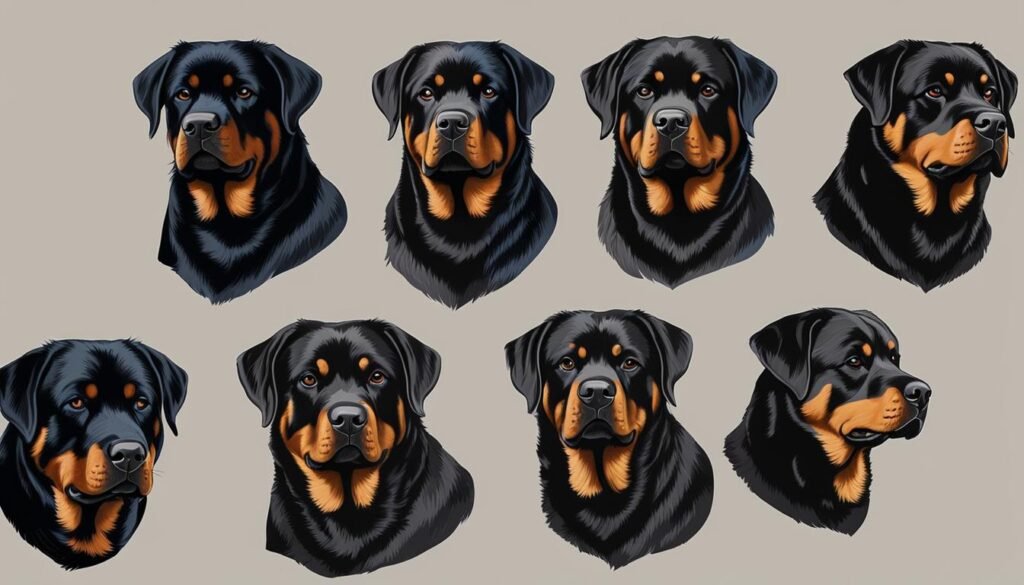
Rottweiler head growth follows a general timeline. In the first year, there is a growth spurt where the head and legs grow faster than the body, making the Rottweiler look lanky and disproportionate. By the second year, the Rottweiler reaches its full height, starts filling out, and develops considerable muscle. Some Rottweilers may continue to gain weight and fill out in their third year. It’s important to note that the head size of a Rottweiler should already be close to full size by the end of the second year.
If you’re unsure about your Rottweiler’s head growth stages, it’s always best to consult with a veterinarian for guidance. They can provide insights tailored to your specific Rottweiler’s development and address any concerns you may have.
Importance of Monitoring Rottweiler Growth
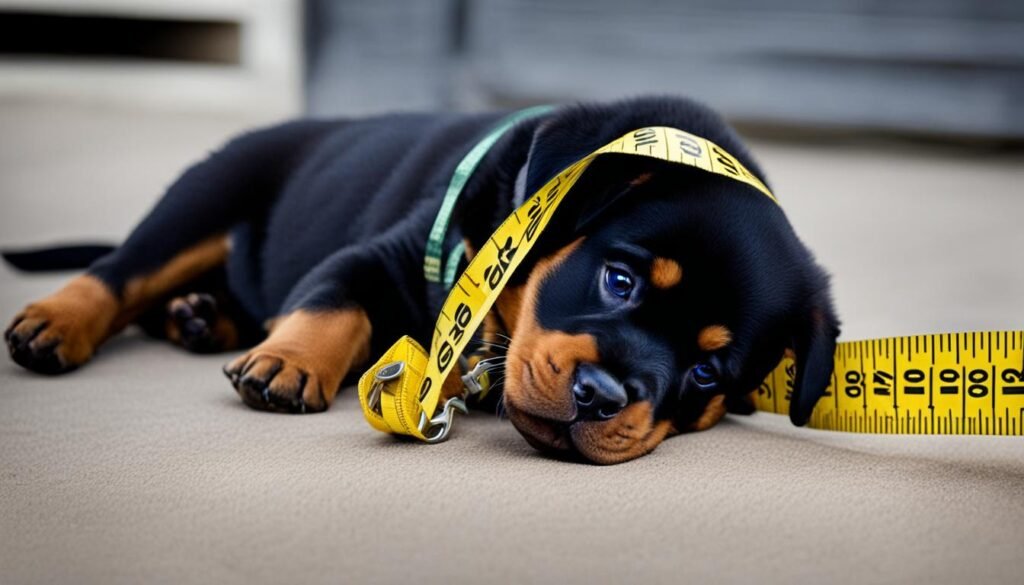
Monitoring a Rottweiler’s growth is vital to ensure they are developing at a healthy pace. It’s important to pay attention to any rottweiler growth concerns or potential health issues that may arise during their growth process.
One significant concern is a Rottweiler growing too quickly. Rapid growth can put undue strain on their joints and muscles, leading to issues such as misalignment and orthopedic problems later in life. By monitoring their growth, you can make sure they are not experiencing any negative consequences from their rapid development.
Conversely, a lack of growth or slow growth can also indicate potential health issues. It may be a signal that something is not quite right with their overall well-being. A Rottweiler that is not growing properly may have an underlying health problem that needs attention from a veterinarian.
To ensure the healthy growth of your Rottweiler, regular check-ups with a veterinarian are crucial. They can monitor your dog’s growth, detect any potential issues, and provide appropriate guidance for their development. A veterinarian may recommend adjustments to diet, exercise routines, or other interventions to support your Rottweiler’s growth and overall health.
By paying close attention to your Rottweiler’s growth and seeking professional advice when needed, you can help ensure their optimal development and well-being throughout their life.
Factors Affecting Rottweiler Head Proportions
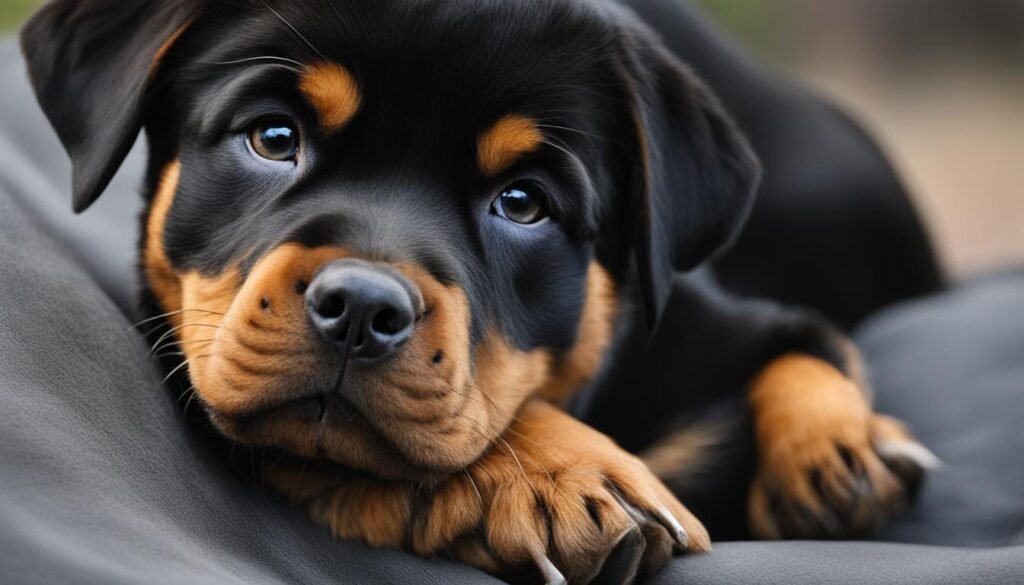
The proportions of a Rottweiler’s head are primarily determined by genetics and breeding. The overall size and shape of the head can vary between individual Rottweilers, but breeding lines play a significant role in influencing the head proportions. The development of the skull is also influenced by genetic factors, which can result in variations in skull shape and size among Rottweilers.
When it comes to the head proportions of a Rottweiler, breeding lines have a significant impact. Rottweilers from different breeding lines may exhibit differences in head size and shape. For example, American Rottweilers typically have lighter heads and a smaller overall size compared to German Rottweilers. German Rottweilers have thicker bones and blockier heads, following stricter breeding standards.
Genetic Factors and Variations
Genetic factors also contribute to the variations in Rottweiler head proportions. While there may be some similarities within breeding lines, individual Rottweilers can still exhibit slight differences in head size and shape due to genetic variations. These variations give each Rottweiler a unique look while still adhering to the breed standards.
It’s essential to understand that Rottweilers bred for specific purposes, such as show dogs or working dogs, may exhibit different head proportions. For example, show dogs often have more emphasis on conforming to breed standards, including head shape and size, while working Rottweilers may have head proportions that prioritize functionality and performance.
Overall Impact on Head Proportions
The combined influence of genetics and breeding lines plays a crucial role in determining the overall size, shape, and proportions of a Rottweiler’s head. While individual variations exist, a well-bred Rottweiler should have a proportionate head that reflects the breed’s standards and characteristics.
Understanding the factors that affect Rottweiler head proportions can provide insight into the unique features of these magnificent dogs. Breeding lines and genetic factors contribute to the formation of their distinctive heads, making each Rottweiler a remarkable and recognizable breed.
Behavior Challenges and Redirecting Chewing
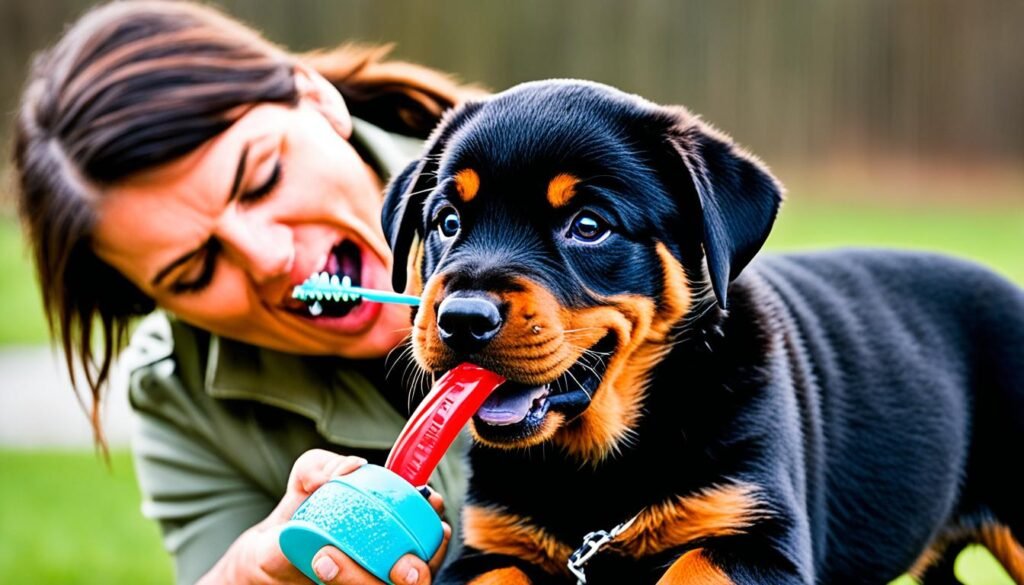
Rottweiler puppies, like many others, may exhibit chewing behavior as they explore the world and relieve teething discomfort. It is important to redirect this chewing behavior to appropriate objects and away from table legs or other inappropriate items.
To effectively redirect chewing behavior, I recommend providing flavorful and durable toys specifically designed for strong chewers. Large flavored Nylabones, natural antlers, and natural bones are excellent options that can withstand vigorous chewing. It is advisable to rotate these toys regularly to keep them interesting and engaging for your Rottweiler puppy.
In addition to providing appropriate toys, you can discourage your puppy from chewing on undesirable objects by using deterrents such as Bitter Apple spray or hot sauce. Applying these substances to table legs or other items you want to protect can help make them unappealing to your Rottweiler.
Consistency is key when redirecting chewing behavior. Whenever you catch your puppy chewing on something they shouldn’t, calmly and gently redirect their attention to an appropriate toy. Positive reinforcement training, rewarding your puppy for chewing on their toys instead of your belongings, can also be beneficial in addressing and curbing unwanted chewing behavior.
Remember that chewing is a natural behavior for puppies, so it is important to redirect their instincts rather than punishing them. By providing alternative outlets for chewing and using positive training techniques, you can help your Rottweiler puppy develop appropriate chewing habits and minimize damage to your home.
Check out the adorable Rottweiler puppy below, eagerly enjoying a durable toy!
Slowing Down Eating with Feeding Bowls
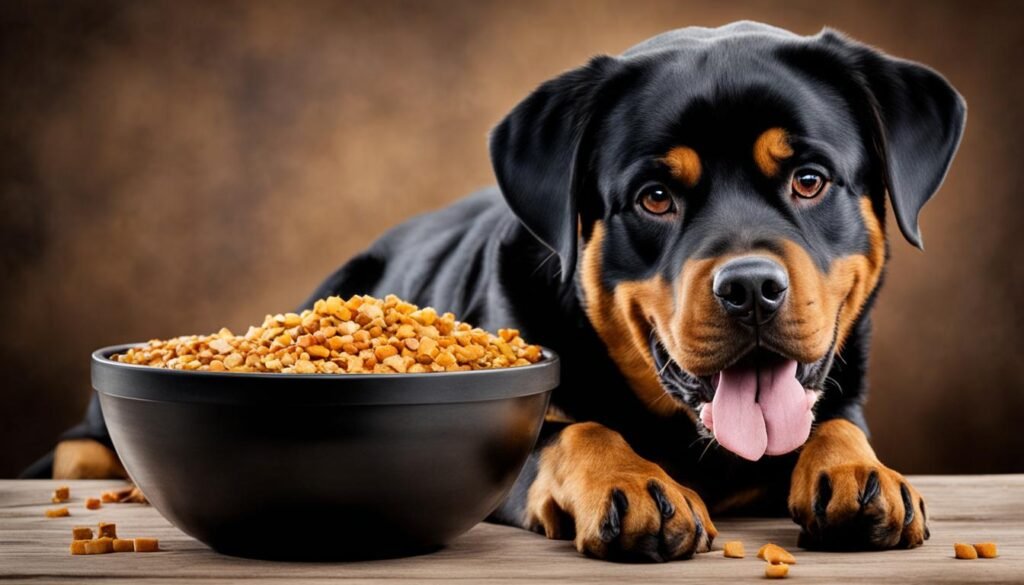
Rottweilers, like many dogs, may have a tendency to eat their food too quickly. This can lead to various digestive issues, including vomiting and discomfort. To address this common problem, consider using specialized feeding bowls designed to slow down your Rottweiler’s eating speed.
Feeding bowls with dividers or maze-like designs can be particularly effective in slowing down your Rottweiler’s eating pace. These innovative designs force your dog to navigate through the bowl, making it more difficult for them to gulp down their food in a hurry. By reducing their eating speed, you help promote better digestion and reduce the risk of bloating, a condition that is common among large, deep-chested breeds like Rottweilers.
Slowing down your Rottweiler’s eating not only improves their overall digestive health but also ensures that they thoroughly chew their food, aiding in proper nutrient absorption. It’s important to note that these feeding bowls should be used as a supplement to a well-balanced diet and should not replace regular, veterinary-approved feeding guidelines.
When Rottweilers Reach Full Growth
Rottweilers have a unique growth timeline, with their heads developing at a slightly faster rate than their bodies. By the time they reach one year of age, Rottweilers typically reach their full height and start to resemble adult dogs. However, it may take another two to three years for them to achieve their full weight and muscular development.
During the first year, Rottweilers experience a growth spurt, with their heads and legs growing faster than their bodies. This phase may result in a lanky and disproportionate appearance. By the second year, Rottweilers have reached their full height, but the bulkiness of their head and body may continue to develop over the next year or two.
After this period, a Rottweiler’s head growth will have stopped, although they may still gain weight if they are not properly exercised or fed a balanced diet. It’s essential to provide them with regular exercise and a high-quality diet to ensure proper development and weight management.
Key Points:
- Rottweilers reach their full height around one year of age.
- It may take two to three years for Rottweilers to achieve their full weight and muscular development.
- The bulkiness of a Rottweiler’s head and body may continue to develop over the next year or two.
- After this time, a Rottweiler’s head growth will have stopped, but they may still gain weight if not properly exercised or fed.
Monitoring a Rottweiler’s growth and ensuring they receive proper veterinary care, nutrition, and exercise play crucial roles in their healthy development. By providing the necessary care, your Rottweiler can grow into a majestic and well-developed adult with a strong and proportionate head.
Ensuring a Healthy Rottweiler Growth
As a responsible Rottweiler owner, ensuring the healthy growth of your furry companion is of utmost importance. By prioritizing regular veterinary check-ups, proper nutrition, and exercise, you can help your Rottweiler thrive and reach their full potential.
Annual veterinary examinations play a crucial role in monitoring your Rottweiler’s growth and overall health. These check-ups allow your veterinarian to assess any concerns, provide necessary vaccinations, and offer guidance on maintaining your Rottweiler’s well-being. Regular discussions with your veterinarian can help address any potential issues and ensure your Rottweiler is on the right track to healthy growth.
Proper nutrition is key to supporting your Rottweiler’s growth. It is recommended to feed them a high-quality, balanced diet that is specifically formulated for large breed puppies. Good nutrition provides the necessary nutrients for healthy bone and muscle development, contributing to a strong and well-proportioned body.
Exercise is an essential component of a Rottweiler’s healthy growth. Engaging in regular physical activities helps build strong muscles, supports joint health, and aids in maintaining an ideal weight. Daily exercise, such as brisk walks or playtime in a securely enclosed area, allows your Rottweiler to expend energy, promotes overall well-being, and helps prevent obesity.
- Take your Rottweiler for daily walks or provide opportunities for them to engage in structured activities.
- Play interactive games with your Rottweiler to stimulate their mind and body.
- Consider enrolling in obedience or agility classes to provide mental and physical challenges for your Rottweiler.
Additionally, considering pet insurance can offer peace of mind and financial support in case of unexpected health issues. Pet insurance helps cover the cost of veterinary care, ensuring that your Rottweiler receives prompt attention and the necessary treatments when needed.
Remember, a healthy Rottweiler is a happy Rottweiler. By prioritizing regular veterinary check-ups, providing a balanced diet, offering daily exercise, and considering pet insurance, you can ensure that your Rottweiler experiences a healthy growth journey, leading to a long and fulfilling life by your side.
Conclusion
Rottweilers have a unique growth timeline, with their heads developing at a slightly faster rate than their bodies. The size and proportions of a Rottweiler’s head are influenced by genetics and breeding lines. It’s important to monitor a Rottweiler’s growth to ensure a healthy and balanced development.
During their growth, Rottweilers may face common challenges such as chewing behavior and fast eating. By redirecting chewing behavior and using feeding bowls to slow down eating, these challenges can be effectively addressed. Additionally, providing proper veterinary care, nutrition, and exercise is crucial for the overall well-being of Rottweilers.
With proper care, Rottweilers can grow into healthy and majestic dogs with well-developed heads. Their growth should be guided by regular monitoring, and any concerns should be discussed with a veterinarian. By understanding the unique characteristics of Rottweiler growth, we can ensure that these remarkable dogs reach their full potential and lead happy and healthy lives.
FAQ
When does a Rottweiler’s head fill out?
A Rottweiler’s head continues to fill out until two to three years of age.
What are the two main types of Rottweiler heads?
Rottweilers can have either a slender skull (typical of an American Rottweiler) or a massive skull (typical of German and European lines).
What is the ideal head size for a Rottweiler?
The ideal head size for a Rottweiler is medium-sized with a good distance between the ears and moderately protruding fronts.
How does a Rottweiler’s head growth progress?
During the first year of a Rottweiler’s life, there is a growth spurt, with the head and legs growing faster than the body. By the second year, the Rottweiler will reach its full height and start to fill out and develop muscle. Some Rottweilers may continue to gain weight and fill out until their third year.
Do male and female Rottweilers have different head sizes?
Yes, male Rottweilers generally have larger head sizes than females. The skull length of a big male Rottweiler is typically around 15 centimeters, while a big female Rottweiler’s skull length is slightly less than 13 centimeters.
Are there differences in head size based on breeding lines?
Yes, Rottweilers from different breeding lines may have variations in head size and shape. American Rottweilers typically have lighter heads and a smaller overall size, while German Rottweilers have thicker bones and blockier heads. Other variations, such as “Serbian Rottweilers,” “Russian Rottweilers,” and “Roman Rottweilers,” are not officially recognized types but rather based on different breeding lines.
What is the growth timeline for a Rottweiler’s head?
In the first year, there is a growth spurt where the head and legs grow faster than the body. By the second year, the Rottweiler reaches its full height, starts filling out, and develops considerable muscle. Some Rottweilers may continue to gain weight and fill out in their third year.
Why is it important to monitor a Rottweiler’s growth?
Monitoring a Rottweiler’s growth is essential to ensure they are growing at a healthy pace. Growing too quickly can put strain on their joints, while a lack of growth can indicate underlying health issues. Regular veterinary check-ups are recommended to address any concerns about growth and overall health.
What factors affect Rottweiler head proportions?
The proportions of a Rottweiler’s head are primarily determined by genetics and breeding. Different breeding lines can result in variations in head size and shape. Additionally, the development of the skull is influenced by genetic factors and can vary between Rottweilers.
How can I address chewing behavior in Rottweilers?
To redirect chewing behavior, provide flavorful and durable toys and rotate them to keep them interesting. Using deterrents like Bitter Apple spray or hot sauce on table legs may discourage chewing. Consistency in redirecting and positive reinforcement training can also help address chewing behavior.
How can I slow down my Rottweiler’s eating?
Feeding bowls with dividers or maze-like designs can help slow down a Rottweiler’s eating pace and prevent gulping. Slowing down eating aids digestion and reduces the risk of bloat, a common condition in large, deep-chested breeds like Rottweilers.
When do Rottweilers reach full growth?
Rottweilers reach their full height around one year of age, but it may take until two or three years for them to reach their full weight and muscular development. By the end of the second year, a Rottweiler’s head will have stopped growing, although they may still gain weight if not properly exercised or fed.
How can I ensure a healthy Rottweiler growth?
Ensuring a healthy Rottweiler growth requires regular veterinary check-ups, proper nutrition, and exercise. Annual examinations, vaccinations, and discussions with a veterinarian can help address any concerns about growth and overall health. Feeding a high-quality, balanced diet appropriate for large breed puppies and providing opportunities for daily exercise are essential.
